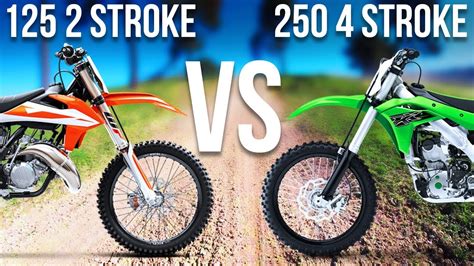Compare the power, torque, and overall performance of 125cc 2-stroke and 250cc 4-stroke motocross bikes. Discover which bike is better suited for different riding styles and terrains.

125 2-Stroke vs 250 4-Stroke: A Comprehensive Comparison
The world of dirt bikes is vast and diverse, with a wide range of options available to riders of all skill levels and preferences. Two popular choices for off-road enthusiasts are the 125 2-stroke and the 250 4-stroke motorcycles. Both bikes offer unique advantages and disadvantages, making the decision between them a matter of personal preference and riding style.
Power and Performance
125 2-Stroke: Known for their explosive power delivery, 125 2-strokes produce quick bursts of acceleration. They are lightweight and agile, making them ideal for navigating tight trails and technical terrain. The powerband is typically narrow, requiring riders to keep the engine in a high RPM range to maintain peak performance.
250 4-Stroke: In contrast, 250 4-strokes offer a more linear power delivery, providing smooth and predictable acceleration. They have better low-end torque, making them easier to ride in a wider range of conditions. While they may not have the same explosive power as 125 2-strokes, 250 4-strokes often have a broader spread of usable power, making them more versatile for different riding styles.
Handling and Agility
125 2-Stroke: 125 2-strokes are typically lighter and more agile than 250 4-strokes, making them easier to maneuver through tight spaces and over obstacles. They are also known for their quick steering response, allowing riders to make rapid changes in direction. However, their lightweight construction can make them more challenging to control at higher speeds.
250 4-Stroke: 250 4-strokes are generally heavier and less agile than 125 2-strokes. Their increased weight provides stability and traction, making them more suitable for riding on rough terrain and at higher speeds. They also tend to have a longer wheelbase, contributing to their stability but reducing their maneuverability in tight spaces.
Reliability and Maintenance
125 2-Stroke: 125 2-strokes are generally considered to be more reliable and easier to maintain than 250 4-strokes. They have fewer moving parts and require less frequent oil changes and valve adjustments. Additionally, 2-strokes can run on a simple pre-mix fuel, eliminating the need for a separate oil reservoir and injection system.
250 4-Stroke: 250 4-strokes are generally more complex and require more frequent maintenance than 125 2-strokes. They have more moving parts, including valves, camshafts, and timing chains, which require regular inspection and adjustment. 4-strokes also require more frequent oil changes and valve adjustments to maintain optimal performance.
Fuel Efficiency and Emissions
125 2-Stroke: 125 2-strokes are generally less fuel-efficient than 250 4-strokes. This is due to their high-revving nature and the fact that they burn a mixture of fuel and oil. Additionally, 2-strokes produce more emissions, including hydrocarbons and smoke, compared to 4-strokes.
250 4-Stroke: 250 4-strokes are generally more fuel-efficient than 125 2-strokes. They burn fuel more efficiently and produce fewer emissions. This makes them a more environmentally friendly option, especially for riders who frequently ride in areas with strict emissions regulations.
Cost and Value
125 2-Stroke: 125 2-strokes are generally more affordable than 250 4-strokes. They are less expensive to purchase and maintain, making them a more budget-friendly option for riders on a tight budget. Additionally, 125 2-strokes hold their value well, making them a good investment for riders who plan to sell or trade their bikes in the future.
250 4-Stroke: 250 4-strokes are generally more expensive than 125 2-strokes. They have a higher purchase price and require more frequent maintenance, resulting in higher overall ownership costs. However, 250 4-strokes often offer better performance and reliability, making them worth the investment for riders who demand the best.
Which Bike Is Right for You?
Ultimately, the decision between a 125 2-stroke and a 250 4-stroke depends on your individual needs, riding style, and budget. If you are a beginner or intermediate rider looking for a lightweight, agile, and affordable bike, a 125 2-stroke may be the better choice. If you are an experienced rider looking for a more powerful, versatile, and fuel-efficient bike, a 250 4-stroke may be the better option.
Here is a table summarizing the key differences between 125 2-stroke and 250 4-stroke dirt bikes:
| Feature | 125 2-Stroke | 250 4-Stroke |
|---|---|---|
| Power Delivery | Explosive, quick acceleration | Smooth, linear acceleration |
| Handling | Lightweight, agile, quick steering | Heavier, more stable, less agile |
| Reliability | Generally more reliable, easier to maintain | Generally less reliable, requires more frequent maintenance |
| Fuel Efficiency | Less fuel-efficient, higher emissions | More fuel-efficient, lower emissions |
| Cost | More affordable, better value for money | More expensive, higher overall ownership costs |


